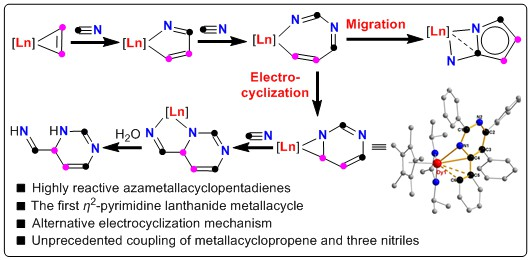Selective Coupling of Lanthanide Metallacyclopropenes and Nitriles via Azametallacyclopentadiene and η2-Pyrimidine Metallacycle
Ze-Jie Lv, Zhengqi Chai, Miaomiao Zhu, Junnian Wei, and Wen-Xiong Zhang*
J. Am. Chem. Soc. 2021, 143, https://doi.org/10.1021/jacs.1c03604. (Cover Art)

Exploring new lanthanide metallacycles and finding their unique chemistry different from the analogues of transition metals are of great interest and importance. In this work, we reported the synthesis, characterization and reactivity toward nitriles of two lanthanide metallacyclopropenes: lutetacyclopropene 2a and dysprosacyclopropene 2b. The selective coupling of 2a and three molecules of PhCN was found for the first time to provide an unexpected fused lutetacycle 3a with one 1,6-dihydropyrimidine ring. Mechanistic studies by DFT calculations reveal that the triple insertion of PhCN into 2a proceeds through four key steps: the insertion of the first PhCN into 2a giving azalutetacyclopentadiene IM1, the insertion of the second PhCN into the Lu−N bond of IM1, the intramolecular electrocyclization providing a highly strained η2-pyrimidine metallacycle, and the insertion of the third PhCN into the Lu−Csp3 bond. Isolation and characterization of two active intermediates: azalutetacyclopentadiene IM1 and η2-pyrimidine dysprosacycle provide critical evidences for the formation of 3a. Furthermore, IM1 was also reported to react with TMSCN, isocyanides or W(CO)6 to furnish the fused [4,5] lutetacycles. The chemistry of two lanthanide metallacyclopropenes with nitriles is significantly different from these metallacyclopropenes of scandium and other metals. Most notably, the azalutetacyclopentadienes, η2-pyrimidine complex, and other metallacycles all represent the first examples in rare-earth organometallic chemistry; the formation of these new lutetacycles provides concrete evidences for understanding the mechanism of transition metal promoted or catalyzed [2+2+2] cycloaddition between alkynes and nitriles.




